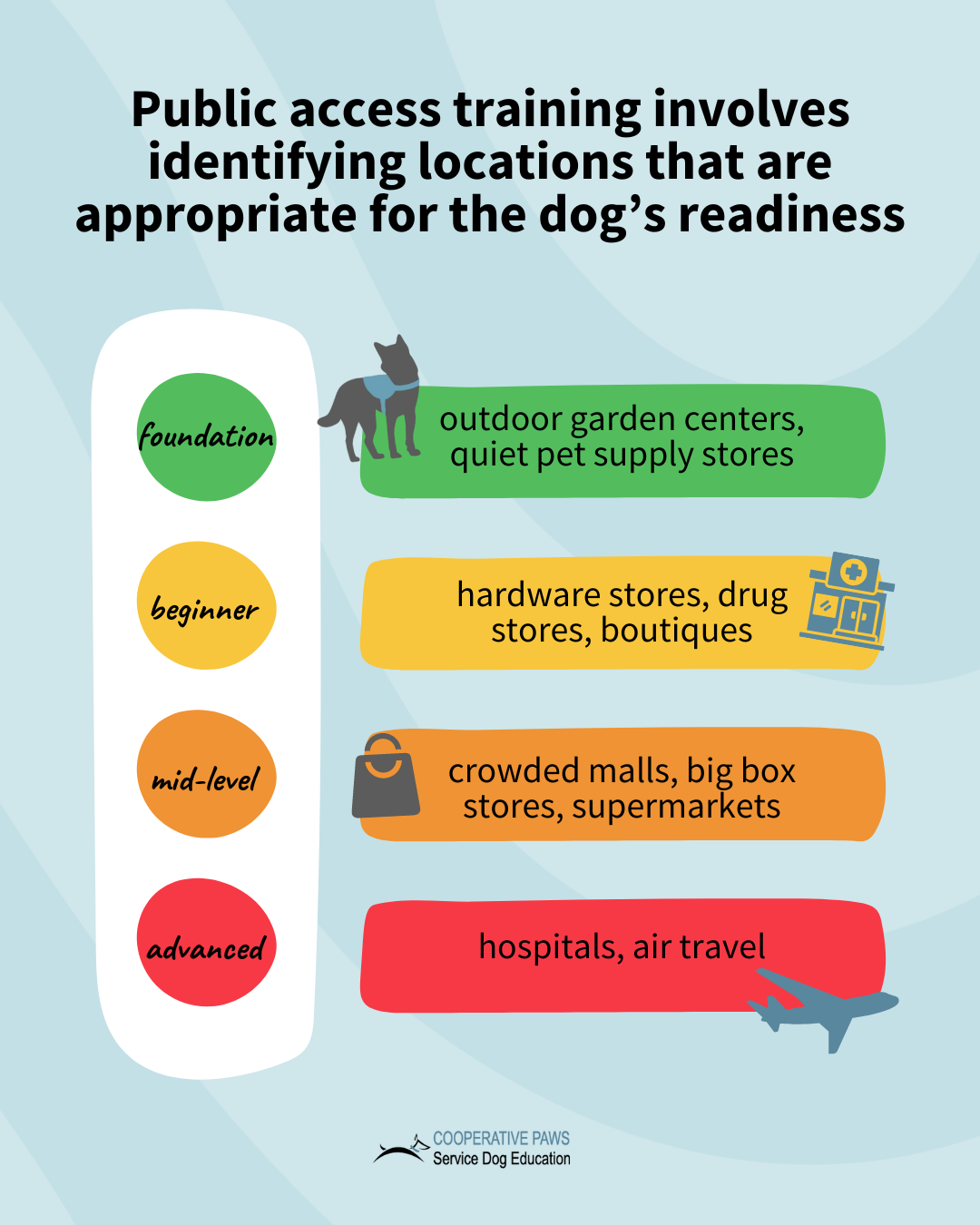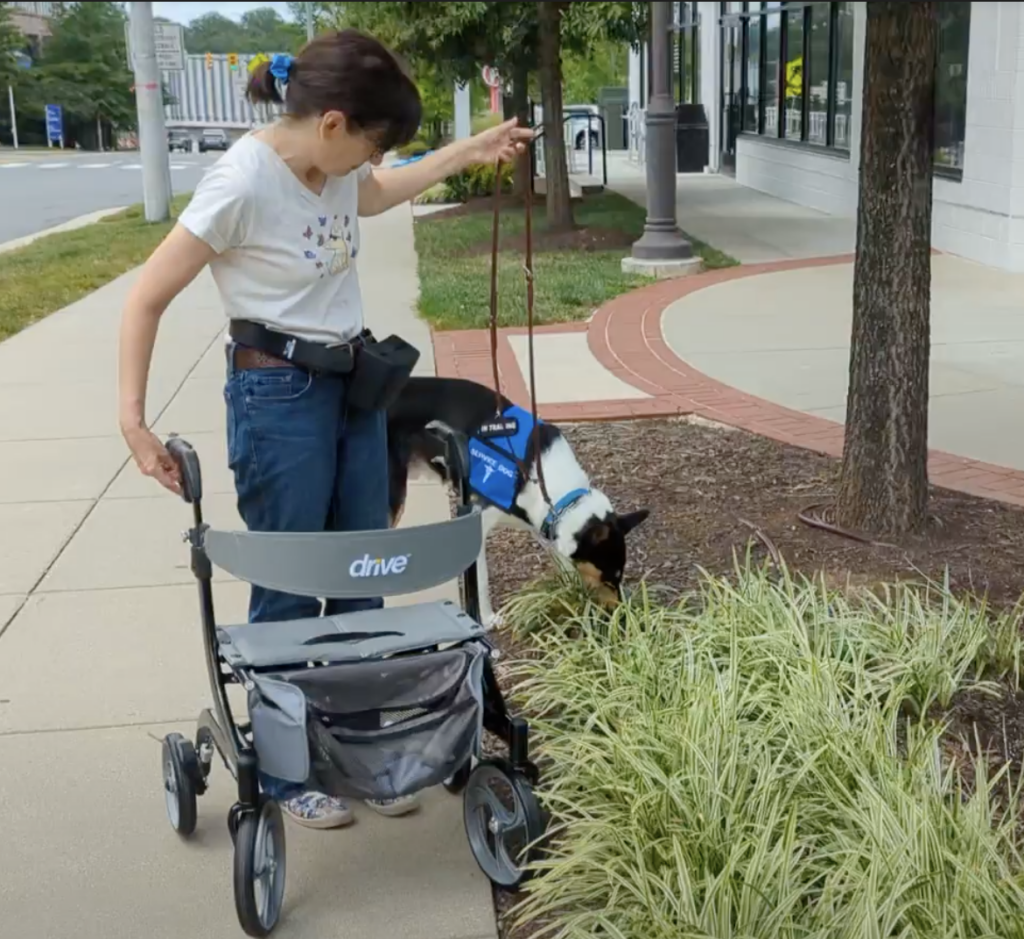Preparing service dogs for public access is an exciting and important aspect of service dog training. Just as with other types of training, it is important to plan public access training sessions carefully to ensure they are successful experiences for both the dog and handler. Take the time to visit the public location you plan to work with the team in ahead of time so you can assess the environment, give the team any information needed and set both the dog and handler up for success.
- Make sure the handler is ready.
In addition to being able to safely handle the dog and mark and reward desired behavior, service dog handlers need to know to check their equipment before taking their dog to a public setting. The leash and any identifying equipment, vest or harness should be in good condition and properly fitted to ensure safety. The dog should be wearing identification and be appropriately groomed and clean. Handlers should know to have clean-up supplies and a wide variety of different training treats. Owners tend to underestimate how many treats they will need while training a dog for public access, so reminding them to bring more treats than they think they will need can be helpful.
- Assess the parking.
Parking lots can be especially hazardous for some clients with disabilities. Clients who use wheelchairs can be difficult for motorists to see, and clients who are deaf or who have low vision can have difficulty safely negotiating parking lots. Identify the location of accessible parking spots so you can give the client information on where they are located. Walk from the accessible parking into the establishment you plan to enter to ensure accessibility; do not assume that businesses are in compliance with the ADA.
Exiting a vehicle with adaptive equipment and a service dog in training can be difficult. For instance, the car door may need to remain open for a longer period of time than usual for a wheelchair to exit. Practice training the dog to exit the handler’s vehicle in a safe, enclosed location first, like inside a garage. That way you can ensure the owner has good control of the dog before working with the team in a public setting. If you think the team may still need extra help, ask the owner to wait in their car and meet them there to help ensure that they are able to safely exit the vehicle and negotiate the parking lot.
- Start with pet-friendly establishments.
More and more locations such as bookstores, garden centers, hardware stores and even some clothing stores allow pets. Pet-friendly businesses are often terrific, low-pressure situations where a team can begin introducing public access training. If the dog barks or sniffs merchandise in a pet-friendly location, it’s not a problem. These locations give the dog an opportunity to gain confidence and explore the environment. If a dog in training is afraid of a display case, for example, you can give the dog the opportunity to sniff the case when the dog is ready. Depending on the location, you also may be able to toss treats on the floor. This is usually inappropriate in non-pet-friendly public access environments. After the team is working well in pet-friendly settings, you can begin working with them in locations that do not allow pets.
- Assess the complexity of the environment and begin in quieter, less complex settings.
There is a big difference between working in a busy mall during the holiday season versus visiting a quiet pharmacy. Service dog candidates need to be introduced to public access environments slowly, beginning with environments that are less crowded and quieter. Look for locations that have easily accessible exits, so it is easy for the owner to remove their dog if needed. Early training field trips should not be to locations where food is sold or where there are narrow aisles. Begin with short visits to locations like banks, computer supply stores or pharmacies during off hours. As the team gains experience you can slowly introduce more complex settings like grocery stores or situations where it is more difficult to find an exit like large indoor malls.
- Keep field trips short at the beginning and plan for breaks.
Initial visits should be short — less than five minutes. Increase time as the dog and handler gain confidence. Gradually work toward increasingly complex settings for longer periods of time. Service dog candidates need an opportunity to relieve themselves immediately before entering a building that normally does not allow pets. In addition to that, they need breaks to decompress from stressors. The exact timing will vary depending on the individual dog, but in most cases with a new dog in training, a break every 30 minutes is a minimum. The dog should be able to sniff and explore and relieve themselves during this down time.
As you plan public access experiences for the team, remember to consider the wide range of settings that the owner will need the dog to work in. Also, if a handler or volunteer will be working the dog in public access without the trainer present, it is especially important to make sure the experiences are truly positive and not overwhelming. Telling an owner to work with the dog in a store “briefly” leaves room for misinterpretation; instead, specify the name and location of the store, how often to visit and the amount of training time needed. Handlers need to be educated on what to do after the visit as well. Quiet down time at home or a sniff and explore walk in a quiet park may be appropriate. It can be tempting for owners to overdo it and take their dog to several stores in a row, which risks overwhelming the dog or triggering stress.
Learn how to train four tasks for PTSD:
PTSD Service Dog Task Training
Because public access training is an exciting and important step in the service dog training process, much of the service dog trainer’s job takes place before the team ever sets foot in a public space together. It’s important to educate the handler about the dog’s needs and provide clear communication about what types of public access experiences are appropriate at what stage of training. Managing the handler’s expectations about the process is equally important. Building this solid foundation will set both members of the team up for success.



